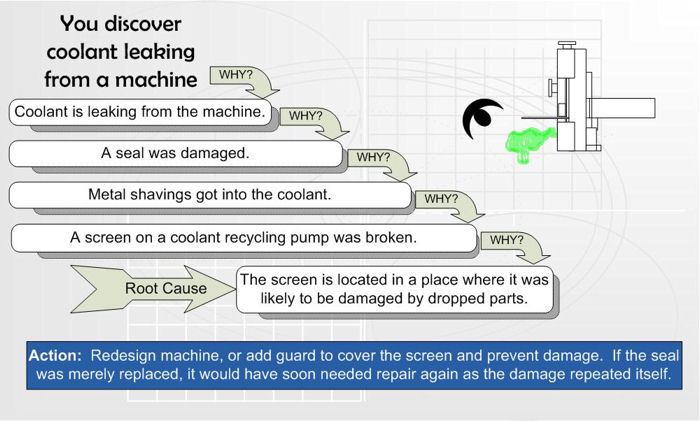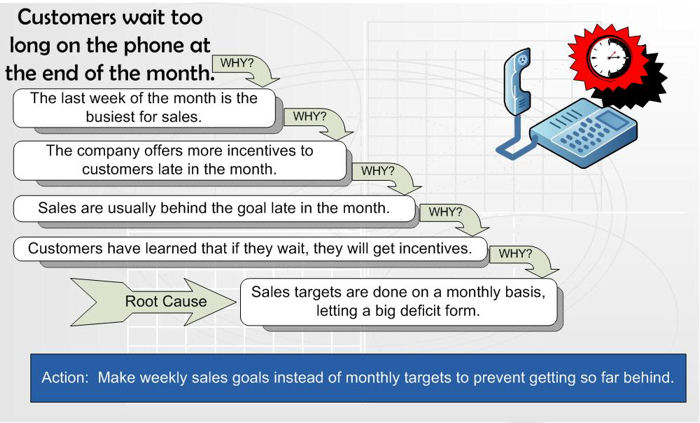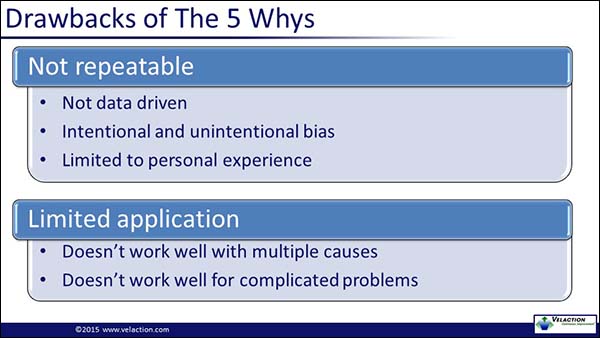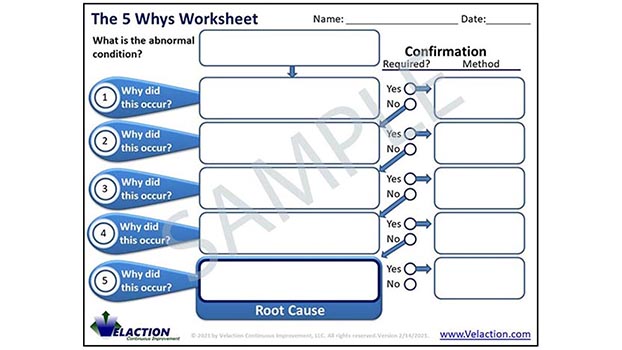5 Whys
The 5 Whys problem solving tool helps you with root cause analysis. It gets you to the heart of a problem.
When you identify an issue or an abnormal condition, ask why it occurred, but don’t stop there. Continue to ask why several more times. Try to go 5 questions deep, or at least continue until you can no longer identify another cause. That is the point where you have found the core of the problem—the original reason it happened.
There might not be exactly 5 “Why’s?”—five is an arbitrary number to remind you to dig deeper into the problem and get past the surface explanation. A run through the 5 whys analysis, though, is usually enough to get to the heart of the issue.
Learn About the 5 Whys Form in our RCA & The 5 Whys Video

Put yourself into the 10-year-old mindset. Anyone with children has experienced the repetitive ‘Why?’ questions that children ask as they try to make sense of the world around them. Kids are eager to learn.
Somewhere along the way, though, adults lose that craving for understanding and settle for the easy answer on the surface. So, what happens if you don’t dig deep enough into an issue? Well, you waste a lot of time and energy because you end up addressing a symptom instead of the real problem.
The 5 Whys prevent you from spending limited resources fixing symptoms instead of resolving problems.
If you don’t eliminate the root cause of a problem, the same symptoms will probably return in the future. Take a moment to look at the following examples.
A 5 Whys Example in Lean Manufacturing

5 Whys Example in the Lean Office

Think about what you might do if you were to ask only one ‘Why?’ and then stop. You might just replace a seal on the machine or put additional people on the phones. In both cases, the action would be much less effective than spending a little more time trying to get to the root cause.
One other point—the 5 Whys can be done as a group exercise. In fact, when groups work together, they often challenge assumptions more than individuals do. This leads to better outcomes.

As simple as the 5 Whys sounds, you will have to watch out for a few pitfalls.
First, don’t be overly aggressive at trying to get exactly five ‘Whys?’
You might get to the third one and just run into a wall trying to find a fourth. You could already be at the root cause. Five is a guideline rather than a hard and fast rule.
The 5 Whys is Easily Biased
You might find some bias in the answers you get. Most individuals have a natural inclination to look away from themselves or their team for the source of a problem. It might take some effort to focus the search inward to get to the real root cause.
Bias also shows up when a team thinks they already know the root cause. The group often, intentionally or unintentionally, directs the flow of the 5 Whys to get to a predetermined answer. Look for lapses in logic where the next ‘Why?’ doesn’t quite follow the previous one. People from different work groups might answer the same question in very different ways.

The 5 Whys is NOT Scientifically Sound
There is one big drawback to the 5 Whys. It is not scientific in the slightest. It draws exclusively from the opinions and observations of the people doing the task.
In fact, several people in the same workgroup may come to different root causes, or the same person might come to a different conclusion if she did the 5 Whys again a short time later. Because this tool is not repeatable, don’t use it by itself in critical situations. Use the 5 Whys to get the analysis going but confirm the results with more robust methods.
In non-critical situations, though, where speed is important, the 5 Whys is an extremely useful tool. It forces people to look deeper into problems than they would if they just winged it. The extra effort of looking more critically at a problem generally brings about better outcomes.
One way to improve results is to try different paths. If a ‘Why?’ has more than one possibility, see where both answers take you, and then look into both root causes that you come up with to see which is more likely, or if there are, in fact, multiple causes for the problem.
Ask the Right People
Finally, figure out who the right people are to answer your ‘Why’ questions. Sometimes, answers are elusive. The person who knows the next ‘Why?’ might be the night shift maintenance tech, or the sales rep for the Great Plains states. The 5 Whys relies heavily on experience to know where to look. Don’t leap to a guess about why something is happening. Take the time to find someone who knows.

How does using the 5 Whys benefit you? Quite simply, it removes frustration. Most employees can give countless examples of problems that just won’t go away—despite repeated attempts to address them. Many of these difficulties can be traced back to improvement efforts that target symptoms, rather than the root cause.
When that happens, the issue goes away for a little while, but comes back, seemingly stronger than ever. This reduces job satisfaction in the process. Go after the root cause to prevent that frustration.

Exclusive Content for this Section is available at academy.Velaction.com

Key Points About the 5 Whys
- Use the 5 Whys to get to the root cause.
- Correcting a symptom, instead of the real problem, wastes resources.
- Correcting a root cause gets rid of problems permanently, improving satisfaction.
- Watch out for bias.
- Spend time finding the right person to answer your questions.
- Be careful not to rely only on the 5 Whys for critical problems.
![]()
Pick a nagging problem that you are facing in your area and do a 5 whys analysis on it. See if the result matches what you initially thought it might be.
Once you identify a problem and a root cause, obviously, you will want to fix it. The thing to watch for, though, is to see if going after the root cause finally eliminates the problem for good.
Please click the ‘Continue Reading’ link below to answer a poll question about the 5 Whys.



10 Comments
capalermo · September 29, 2014 at 12:14 pm
I have the same problem, can download the 6 page pdf why’s? I been trying for wile.
Jeff Hajek · September 29, 2014 at 1:25 pm
Sorry about the trouble. The most common problem is that the person trying to download is no logged in. Can you confirm that you were, in fact, logged in when downloading, please? If you were, can you describe what you did and what happened?
Thanks,
Jeff
hphillips · July 18, 2011 at 6:15 am
The ‘5 Whys’ has always been one of my favourite quality tools, and interestingly it was also used at a Accident Investigation training course I recently attended.
The explanation you give here is very clear and thorough, and the way the Worksheet is presented is great. Many thanks!
Jeff Hajek · July 18, 2011 at 9:49 am
Thanks for the comment. I hadn’t heard of it being taught as an accident investigation technique before, so I learned something new. That makes it a good day already!
Regards,
Jeff
ali anani · November 3, 2010 at 3:49 am
Hello Jeff, this site makes a fantastic reading. The site is informative and adds value.
I have recently published a presentation on slideshare that challenges the five whys and suggets its extension to eight whys? Why? The reasoning is in the presentation
The link is
http://www.slideshare.net/hudali15/extend-the-five-whys-to-eight-whys-why
Jeff Hajek · November 9, 2010 at 11:04 am
Ali,
Thanks for the compliment. I appreciate you adding the link. Always nice to add more information to the conversation.
Regards,
Jeff
Zarqa Ghauri · May 5, 2010 at 12:07 pm
I don’t seem to find the 6 page PDF on 5 whys. Would you please direct me to the right page. Thanks,
Jeff Hajek · May 5, 2010 at 12:26 pm
Zarqa,
Sorry about the confusion. It is on this page (https://www.velaction.com/5-whys/) right next to the VIP icon. It is the link labeled 5 Whys Training.
Enjoy!
Jeff
ronettes · September 21, 2012 at 4:30 am
Hi Jeff
I am sure that i see the “VIP” icon? I am also looking for this 6 page Whys Training.
Kind Regards
Ronette
Jeff Hajek · September 21, 2012 at 5:26 am
Ronette,
Those VIP directions were from an old layout. Now, all you have to do is click the image below where it says ‘Download this term on PDF’ at the top left of the page. You’ll have to be logged in to get it.
Sorry about the confusion, and thanks for your interest in our 5 whys information.
Regards,
Jeff Hajek